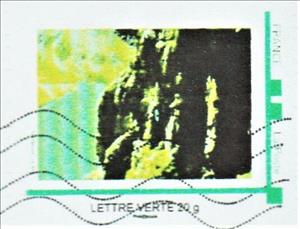Stamp: Cliff (France- Personalized stamps 2022)
Cliff (France- Personalized stamps 2022)
01 January (France- Personalized stamps ) within release Collectors : Montimbramoi. Miscellaneous goes into circulation Stamp Cliff face value Lettre No Face Value
| Stamp Cliff in catalogues | |
|---|---|
| Colnect codes: | Col: FR-MON 2022-6 |
Stamp is square format.
Also in the issue Collectors : Montimbramoi. Miscellaneous:
- Stamp - Cosmetics face value Prioritaire;
- Stamp - "Non a la Cris Atitude" www.espacecanin.net face value Prioritaire;
- Stamp - AES Logo face value Prioritaire;
- Stamp - Arphilatelie face value Monde;
- Stamp - Cliff face value Lettre;
- Stamp - Grenoble Bastille cable car face value Prioritaire;
- Stamp - Ivy Geraniums face value Monde;
- Stamp - Labo Adequat face value Prioritaire;
- Stamp - Onagan face value Prioritaire;
- Stamp - You cannot, You have maths,Tu peux pas, T'as maths face value Prioritaire;
- Stamp - 100% Pilotes du Courrier face value Prioritaire;
- Stamp - Aab Logo face value Prioritaire;
- Stamp - Annick Floriste face value Prioritaire;
- Stamp - Clermont de l'Oise face value Prioritaire;
- Stamp - Pole France Jeunes Handisport face value Prioritaire;
- Stamp - Raccoon Zoo Guadeloupe face value Prioritaire;
- Stamp - Smdt Transport Marseille face value Prioritaire;
- Stamp - Village-Neuf face value Lettre;
- Stamp - Argedis face value Prioritaire;
- Stamp - Gaston Vuillier Defenseur des Cascades de Gimel face value Lettre;
- Stamp - Marat Electrician face value Lettre;
- Stamp - Soyez Sport Rafting face value Prioritaire;
- Stamp - Choteau face value Lettre;
- Stamp - Innocent face value Lettre;
- Stamp - K7 logo face value Prioritaire;
- Stamp - Les Timbres de l'Orthographe face value Prioritaire;
- Stamp - Maison Horspist Paris face value Lettre;
- Stamp - Mercedes Benz Live face value Prioritaire;
- Stamp - Piaget face value Prioritaire;
- Stamp - RSI Regime Social des Independents face value Prioritaire;
- Stamp - Sahuc & Katchoura Architectes face value Prioritaire;
- Stamp - Tower. Muneau Tour XI face value Prioritaire;
- Stamp - Tower/castle in the mountains face value Lettre;
- Stamp - Appscho face value Lettr;
- Stamp - Artisanal Eternity Ring face value Lettre;
- Stamp - Le Joker Restaurant face value Lettre;
- Stamp - Oeuvres Caritatives Militia Christi face value Lettre;
- Stamp - Vos Yeux sont Precieux face value Prioritaire;
- Stamp - Association les Fleurs de la Memoire face value Monde;
- Stamp - AXA Assurances face value Lettre;
- Stamp - CA 34 Archi Concept 34 face value Lettre;
- Stamp - Cabinet Even du Fou face value Prioritaire;
- Stamp - Camping Solaire France face value Prioritaire;
- Stamp - Club Philatelique Lambersartois face value Prioritaire;
- Stamp - Coulommiers Cheese face value Prioritaire;
- Stamp - Dracy-le-Fort Mairie face value Lettre;
- Stamp - Gingko 500th Chiens guides face value Prioritaire;
- Stamp - Happy Birthday. Joyeux Anniversaire. face value Lettre;
- Stamp - Intemporelles Culture Societe Development Durable face value Lettre;
- Stamp - Pragma Services face value Prioritaire;
- Stamp - Sauvetage Chien Shar Pei face value Lettre;
- Stamp - Vintage Photo of Boxer face value Lettre;
Stamp Cliff it reflects the thematic directions:
A landscape is the visible features of an area of land, its landforms and how they integrate with natural or man-made features. A landscape includes the physical elements of geophysically defined landforms such as (ice-capped) mountains, hills, water bodies such as rivers, lakes, ponds and the sea, living elements of land cover including indigenous vegetation, human elements including different forms of land use, buildings and structures, and transitory elements such as lighting and weather conditions. Combining both their physical origins and the cultural overlay of human presence, often created over millennia, landscapes reflect a living synthesis of people and place that is vital to local and national identity. The character of a landscape helps define the self-image of the people who inhabit it and a sense of place that differentiates one region from other regions. It is the dynamic backdrop to people’s lives. Landscape can be as varied as farmland, a landscape park, or wilderness. The earth has a vast range of landscapes, including the icy landscapes of polar regions, mountainous landscapes, vast arid desert landscapes, islands and coastal landscapes, densely forested or wooded landscapes including past boreal forests and tropical rainforests, and agricultural landscapes of temperate and tropical regions.
In geology, rock (or stone) is any naturally occurring solid mass or aggregate of minerals or mineraloid matter. It is categorized by the minerals included, its chemical composition, and the way in which it is formed. Rocks form the Earth's outer solid layer, the crust, and most of its interior, except for the liquid outer core and pockets of magma in the asthenosphere. The study of rocks involves multiple subdisciplines of geology, including petrology and mineralogy. It may be limited to rocks found on Earth, or it may include planetary geology that studies the rocks of other celestial objects.


